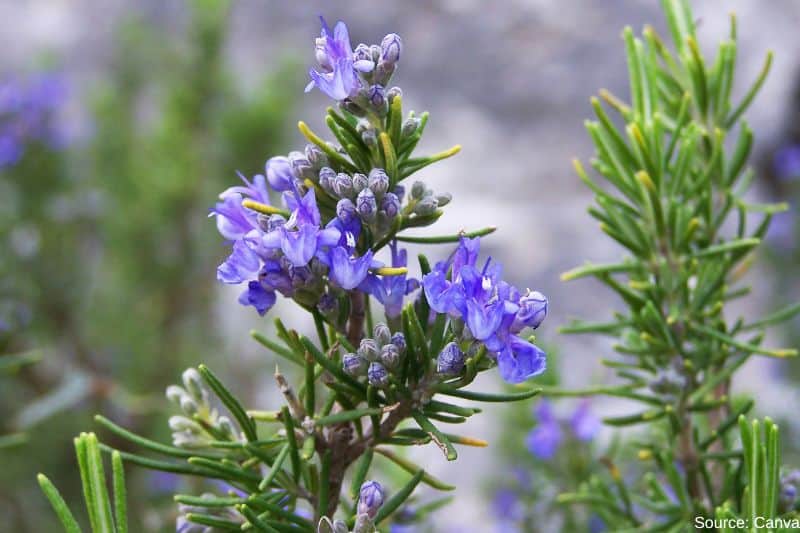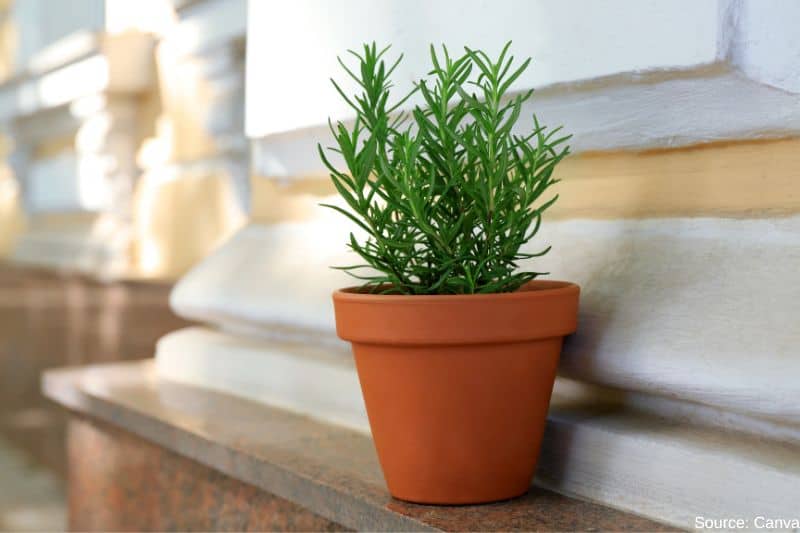If you’re an herb lover, chances are you have rosemary in your herb list. This evergreen herb doesn’t just keep your garden looking green all year round; it has a sheer number of uses, spanning from medicinal and decorative to culinary and pest control.
But then, sometimes — despite the amount of effort you put into keeping your herbs healthy — things just don’t go as expected when growing rosemary. For instance, you might notice your rosemary plants browning and some even dying.
So, what is the reason for your rosemary turning brown and some of them even dying?
To keep it simple, rosemary browning is often a result of poor watering practices, unfavorable growing conditions, and pest infestation.
Of course, there are more reasons for the herb to turn brown, so keep reading to grasp the whole picture.
Read: Why Are My Lavender Leaves Curling? (How to Prevent it?)
8 Top Reasons Rosemary Turn Brown And Sometimes DIE
Rosemary, scientifically known as Rosmarinus officinalis L., is a perennial shrub in the mint family. It is native to the hills along the Mediterranean, Portugal, and Northwestern Spain.
Now, when healthy, the needle-shaped leaves of the rosemary herb should be dark green on the upper surface and powdery white and hairy on the underside.
So, once you begin to notice the color of the leaves turning brown, that’s a tell-tale sign that something is wrong.
Let’s dive into some of the possible reasons for the change in color:
1. Overwatering
While water is one of the basic necessities for your rosemary, overdoing it can stir up trouble. When overwatered, rosemary can turn brown, and may even eventually die from it.
So, what makes overwatering dangerous?
Well, excess water can cause browning in rosemary in three ways.
For one, excess water can cause root rot, which hinders the absorption of water and nutrients. Without enough water and nutrients, the herb will dehydrate and starve, eventually turning brown.
Usually, root rot begins with the yellowing of the leaves — typically beginning with those on the lower part of the plant before spreading to the ones on the upper. They will then begin to drop with time. At this time, you will also notice the foliage browning and possibly a decaying smell coming from the roots.
The other way overwatering can cause browning is by stripping away the nutrients. Excess water washes away important soil nutrients, leaving your herbs with little to fuel their growth. With time, the lack of nutrients will reflect in the browning of leaves.
Lastly, overwatering can attract pathogen-loving insects to your garden, which can cause diseases that lead to browning and death of rosemary.
If you suspect overwatering is the issue, cut back on watering and ensure proper drainage for your plants. Additionally, avoid planting them in compacted soil or containers that hold too much water.
2. Poor Soil Drainage
The other possible reason for the browning of rosemary is poor soil drainage. As mentioned earlier, rosemary thrives in well-draining soils with good airflow.
When the soil remains soggy and waterlogged for too long, it can cause root rot, which leads to browning and eventual plant death.
So, if you think your watering practices are in check, consider the type of soil your rosemary is planted in. If it’s heavy and clay-like, then that could be the reason for poor drainage.
To prevent this issue, make sure to plant your rosemary in a well-drained area or use a potting mix specifically designed for herbs. Additionally, avoid overwatering and ensure proper drainage in your garden or containers.
3. Underwatering
We’ve seen that overwatering is bad for your rosemary. But do you know that underwatering can be just as deadly?
When your rosemary is not getting enough water, the leaves will start to dry out and eventually turn brown. This is because the plant needs enough water to photosynthesize and maintain its green color.
Sure, rosemary is a hardy herb that can survive in harsh conditions, but it still needs water to thrive.
So, make sure to give your rosemary enough water without overdoing it.
4. Too Much Sun
Rosemary, like most other herbs, appreciates a good amount of sunlight. In fact, they love it so much.
Sunlight helps rosemary plants produce essential oils that make them flavorful and aromatic. However, when the sun becomes too much, it can also be harmful to your rosemary plants.
Exposure to intense sunlight for prolonged periods can cause sunburn, which can cause the leaves to start to turn brown — especially if the plant is potted!
Just ensure your plants receive 6 hours of direct sunlight each day. Any excess of that can cause more harm than good.
5. Pest Infestation
Just so you know, insects love feasting on rosemary just as much as we love using it for cooking. Some of the common pests that can attack your rosemary plants include mealybugs, spider mites, and aphids.
When these pesky creatures infest your plant, they will suck out the sap from the leaves, which leads to browning and wilting. They also spread diseases, which cause further damage to your plants.
So, if your rosemary is beginning to pick up a brown coloration, take a keen look at the plant’s leaves and stems. If you see any signs of insects or eggs, that could be the reason for the browning.
6. Extreme Temperature Conditions
Is your rosemary exposed to freezing temperatures or sweltering heat? Well, as much as rosemary can withstand a wide range of temperatures, extreme conditions can cause it to turn brown.
Rosemary herbs are winter hardy only to about 20F (-6C). In fact, they thrive best when the temperature is between 55 and 80 degrees Fahrenheit (12.7 to 26.7°C). So, if your current locality is experiencing temperatures below this, your rosemary will definitely suffer and show it through browning.
On the other hand, if your rosemary is exposed to too much heat, it can also cause browning and wilting of leaves. This is because extreme heat can dry out the soil quickly, depriving the plant of water and leading to dehydration.
7. Moisture-Intense Atmosphere
Excess moisture in the air can also cause browning of rosemary leaves.
Typically, in humid conditions, plants tend to absorb more water from the atmosphere. And if your rosemary is planted in an area with high humidity levels, it will take up more water than it needs, leading to browning and wilting of leaves.
So, if you live in a humid area, monitor your watering practices carefully to ensure proper airflow around your plants.
8. Excess Fertilizer
Have you been giving your rosemary some occasional booster shots of fertilizer? Well, surprise surprise! Too much fertilizer can also cause the browning of your rosemary plants.
That’s true!
You see, excess fertilizer can cause fertilizer burns, which simply means the plant gets too much of certain nutrients than it needs. This leads to browning and wilting of leaves, as well as stunted growth.
Make sure to follow the recommended dosage when fertilizing your rosemary plants, and avoid overdoing it.

How To Fix Browning Rosemary Leaves
Now that you know the possible causes of browning in rosemary, it’s time to explore some solutions to fix this issue and nurse your herbs back to health.
Thankfully, browning in rosemary can be reverted, especially if caught early on. Here are some possible solutions:
1. Embrace Healthy Watering Habits
If your assessment shows that overwatering or underwatering is the cause of browning in your rosemary, then it’s time to adjust your watering habits.
Rosemary needs deep watering once every other week. And get this: It should only happen after you’ve confirmed that the top 2 inches of soil are dry.
You can use your finger to determine this. By using the finger test, you ensure that your plant has enough water to thrive without getting too much.
For younger plants that are yet to establish their root systems, you may need to water them more often, such as twice a week. Just make sure not to overdo it and to switch to the recommended watering schedule once the plants mature.
2. Replant in Well-Draining Soil
If your rosemary is planted in heavy clay-like soil that doesn’t drain well, consider transplanting it to a different location with better draining conditions or use a potting mix specifically designed for herbs.
Ideally, the mix should consist of 80% potting soil and 20% sand or grit to improve drainage. You can also add some compost for added nutrients.
In case you suspect the problem to be with the container you’re using, punch more holes to improve the drainage. More holes will ensure that the soil doesn’t remain soggy for extended periods which could potentially attract root rot.
3. Monitor Sun Exposure
In case you notice your rosemary getting too much exposure to the sun leading to browning, consider moving it to a spot with partial shade or provide some shade using a cover cloth.
This will help protect the plant from direct sunlight while still allowing it to receive enough light for photosynthesis.
4. Combat Pests
If bugs are wreaking havoc on your rosemary, make sure to act fast. Try showering the herbs with a garden hose to see if it solves the problem. If it doesn’t, try using other appropriate methods, such as insecticidal soap or neem oil.
If possible, you can also give a shot to natural methods like introducing ladybugs or lacewings, which feed on these pests, to your garden. Just make sure to do thorough research before trying any pest control methods to avoid causing more harm than good.
5. Adjust Temperature and Humidity Levels
In case you’ve noticed your rosemary suffering from extreme temperatures or excess humidity, try to adjust the conditions by moving it to a more suitable location, providing proper ventilation, or using a humidifier/dehumidifier.
Read: Why Are My Aloe Vera Leaves Curling? 7 Possible Reasons
6. Be Careful with Fertilizer
If you suspect that over-fertilizing is causing the browning of leaves in your rosemary plants, stop fertilizing for some time and let the plant recover.
Once it shows signs of improvement, resume fertilizing but follow the recommended dosage and frequency.






